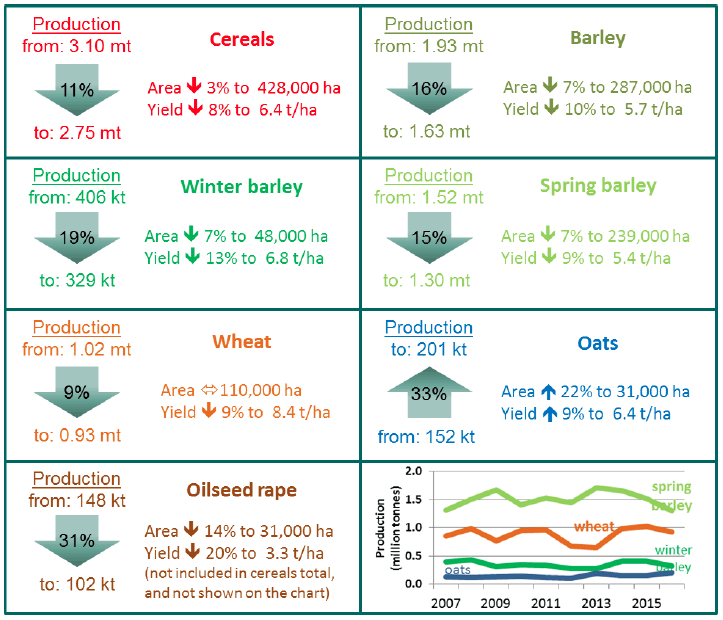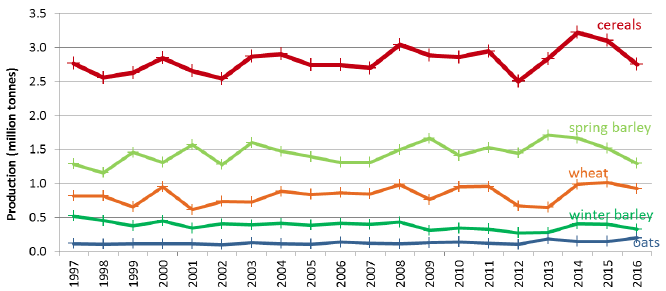Cereal and oilseed rape harvest: final estimates - 2016
Final estimates of the cereal and oilseed rape harvest for Scotland 2016.
1. Main findings

Area, yield and production definitions
Cereal and oilseed rape crop areas represent the amount of area that has been used to grow a particular crop, which is intended for combine-harvesting and the production of grain or oilseeds. Area estimates are derived from the June Agricultural Census and specifically exclude any areas of cereals which are not intended for combine harvesting. "Whole crop" cereals are harvested without extracting the grain, and are used as a source of animal feed.
Average yields are expressed in tonnes per hectare and represent the amount of cereal grain or oilseed that is extracted from one hectare of combine-harvested area. As the moisture content of cereals and oilseeds can vary from year-to-year and farm-to-farm, depending on the level of rainfall, average yields are adjusted to a standard moisture content of 14.5 per cent for cereals and nine per cent for oilseeds. This adjustment ensures there is consistency in estimates of the amount of dry matter which can be extracted from cereal grain and oilseeds.
Production estimates are derived by multiplying crop areas (in hectares) and average yields (in tonnes per hectare). They represent the total tonnage of cereal grain and oilseed that is combine-harvested from the planted area. This tonnage does not include the weight of straw and other plant material which is produced as a by-product and used for other purposes.
When discussing production and area we are referring to estimated totals. When discussing yield we are referring to estimated averages.
Cereal production is estimated to have fallen by 348,000 tonnes between 2015 and 2016, to 2.75 million tonnes. The overall decrease in production this year is due to a three per cent decline in areas, which has been driven by reduced areas of barley. Overall estimates of yield have fallen to 6.4 tonnes per hectare.
Yields for spring barley and oilseed are higher than estimated in early (first) estimates released in October, and lower for wheat, winter barley and oats. The average cereal yield is less than one per cent lower than previously estimated.
The recent 10-year average yield is five per cent above the previous decade's. Long term increases are likely to be due to improved efficiency in practices, development and use of high yielding varieties.
These estimates indicate that, compared with final estimates from the 2015 harvest:
- Spring barley production decreased by 15 per cent to 1.3 million tonnes due to a seven per cent decrease in planted area and a nine per cent decrease in the average yield.
- Winter barley production fell by 19 per cent to 329,000 tonnes due to a seven per cent reduction in area and a 13 per cent reduction in average yield.
- Wheat production decreased by nine per cent to 926,000 tonnes due to a nine per cent decrease in yield. Planted area remained unchanged.
- Oat production increased by 33 per cent to 201,000 tonnes due to a 22 per cent increase in area and a nine per cent increase in yield.
- Oilseed rape production fell by 31 per cent to 102,000 tonnes due to a 14 per cent decrease in area and a 20 per cent fall in yield.
Chart 1: Cereal Production Trends, 1997 to 2016

Harvest Conditions
There was no one explanation for why the 2016 harvest was relatively poor. There was a three per cent reduction in the overall sown area, probably partly due to expected poor returns and partly due to greening requirements. High winds spoilt the oilseed harvest, but there were no particular meteorological issues affecting the cereals. There was however less than ideal weather at several stages of the cycle, and the relatively wet weather last winter possibly meant the seed beds were less than ideal. A low expectation of price may also have led some farmers to reduce inputs, but the lack of warmth and sunlight during the summer meant that this yielded smaller grain.
Contact
There is a problem
Thanks for your feedback